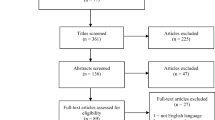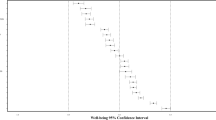Abstract
Data from the 2010 Baylor Religion Survey were analyzed by structural equation modeling (SEM) to test five hypotheses: (1) that religious commitment is positively related to belief in life-after-death; that belief in life-after-death is (2) positively related to belief in an equitable world, and (3) negatively related to belief in a cynical world; (4) that belief in a cynical world has a pernicious association with psychiatric symptoms; and (5) that belief in an equitable world has a salubrious association with psychiatric symptoms. As hypothesized, religious commitment was positively related to belief in life-after-death (β = .74). In turn, belief in life-after-death was negatively associated with belief in a cynical world (β = −.16) and positively associated with belief in an equitable world (β = .36), as hypothesized. SEM further confirmed that belief in a cynical world had a significant pernicious association with all five classes of psychiatric symptoms (β’s = .11 to .30). Belief in an equitable world had a weaker and less consistent salubrious association with psychiatric symptoms. The results are discussed in the context of ETAS theory.

Similar content being viewed by others
References
Arbuckle, J. L. (2008). Amos 17.0 user’s guide. Crawfordville, FL: Amos Development Corporation.
Baxter, L. R. (2003). Basal ganglia systems in ritualistic social displays: Reptiles and humans; function and illness. Physiology & Behavior, 79, 451–460.
Beck, A. T., Emery, G., & Greenberg, R. L. (1985). Anxiety disorders and phobias: A cognitive perspective. New York: Basic Books.
Bentler, P. M. (1990). Comparative fit indexes in structural models. Psychological Bulletin, 107(2), 238–246.
Bentler, P. M., & Bonnett, D. G. (1980). Significance tests and goodness of fit in the analysis of covariance structures. Psychological Bulletin, 88(3), 588–606.
Bering, J. M. (2006a). The cognitive science of souls: Clarifications and extensions of the evolutionary model. Behavioral and Brain Sciences, 29(5), 486–493.
Bering, J. M. (2006b). The folk psychology of souls. Behavioral and Brain Sciences, 29(5), 453–462.
Bhar, S. S., Brown, G. K., & Beck, A. T. (2008). Dysfunctional beliefs and psychopathology in borderline personality disorder. Journal of Personality Disorders, 22(2), 165–177.
Boyer, P. (2006). Prosocial aspects of afterlife beleifs: Maybe another by-product. Behavioral and Brain Sciences, 29(5), 466.
Bradshaw, M., & Ellison, C. G. (2010). Financial hardship and psychological distress: Exploring the buffering effects of religion. Social Science and Medicine, 71(1), 196–204.
Browne, M. W., & Cudeck, R. (1993). Alternative ways of assessing model fit. In K. Bolen & J. Long (Eds.), Testing structural equation models (pp. 136–162). Newbury Park, CA: Sage.
Byrne, B. M. (2001). Structural equation modeling with AMOS: Basic concepts, applications, and programming. Mahmaw, NJ: Lawrence Erlbaum.
Chittick, W. C. (1992). Your sight today is piercing: The Muslim understanding of death and afterlife. In H. Obayashi (Ed.), Death and afterlife: Perspectives of the world religions (pp. 125–139). New York: Greenwood Press.
Cohen, D., & Consoli, A. (2006). Production of supernatural beliefs during Cotard’s syndrome: A rare psychotic depression. Behavioral and Brain Sciences, 29(5), 468–470.
Eilam, D., Izhar, R., & Mort, J. (2011). Threat detection: Behavioral practices in animals and humans. Neuroscience and Biobehavioral Reviews, 35(4), 999–1006.
Ellison, C. G., Burdette, A. M., & Hill, T. D. (2009). Blessed assurance: Religion, anxiety, and tranquility among US adults. Social Science Research, 38(3), 656–667.
Fenigstein, A., & Vanable, P. A. (1992). Paranoia and self-consciousness. Journal of Personality and Social Psychology, 62(1), 129–138.
Flannelly, K. J., Ellison, C. G., Galek, K., & Koenig, H. G. (2008). Beliefs about life-after-death, psychiatric symptomology and cognitive theories of psychopathology. Journal of Psychology & Theology, 36, 94–103.
Flannelly, K. J., & Galek, K. (2010). Religion, evolution, and mental health: Attachment theory and ETAS theory. Journal of Religion and Health, 49(3), 337–350.
Flannelly, K. J., Koenig, H. G., Ellison, C. G., Galek, K., & Krause, N. (2006). Belief in life after death and mental health: Findings from a national survey. Journal of Nervous and Mental Disease, 194(7), 524–529.
Flannelly, K. J., Koenig, H. G., Galek, K., & Ellison, C. G. (2007). Beliefs, mental health, and evolutionary threat assessment systems in the brain. Journal of Nervous and Mental Disease, 195(12), 996–1003.
Gilbert, P. (1984). Depression: From psychology to brain state. Hillsdale, NJ: Lawrence Erlbaum.
Gilbert, P. (1998a). Evolutionary psychopathology: Why isn’t the mind designed better than it is? British Journal of Medical Psychology, 71(Pt 4), 353–373.
Gilbert, P. (1998b). The evolved basis and adaptive functions of cognitive distortions. British Journal of Medical Psychology, 71(Pt 4), 447–463.
Gilbert, P. (2001). Evolution and social anxiety. The role of attraction, social competition, and social hierarchies. Psychiatric Clinics of North America, 24(4), 51–72.
Gilbert, P. (2002). Evolutionary approaches to psychopathology and cognitive therapy. Journal of Cognitive Psychotherapy: An International Quarterly, 16(3), 263–294.
Gilbert, P. (2007). Evolved minds and compassion in the therapeutic relationship. In P. Gilbert & R. L. Leahy (Eds.), The therapeutic relationship in cognitive behavioural psychotherapies (pp. 107–142). London: Routledge.
Gjersoe, N. L., & Hood, B. M. (2006). The supernatural guilt trip does not take us far enough. Behavioral and Brain Sciences, 29(5), 473–474.
Greeley, A. M., & Hout, M. (1999). Americans’ increasing belief in life after death: Religious competition and acculturation. American Sociological Review, 64(6), 813–835.
Green, M. J., & Phillips, M. L. (2004). Social threat perception and the evolution of paranoia. Neuroscience and Biobehavioral Reviews, 28(3), 333–342.
Haraldsson, E. (2006). Popular psychology, belief in life after death and reincarnation in the Nordic counties. Western and Eastern Europe. Nordic Psychology, 58(2), 171–180.
Harding, S. R., Flannelly, K. J., Weaver, A. J., & Costa, K. G. (2005). The influence of religion on death anxiety and death acceptance. Mental Health, Religion and Culture, 8(4), 253–261.
Harley, B., & Firebaugh, G. (1993). Americans’ belief in an afterlife: Trends over the past two decades. Journal of the Scientific Study of Religion, 32(3), 269–278.
Harris, S., Sheth, S. A., & Cohen, M. S. (2008). Functional neuroimaging of belief, disbelief, and uncertainty. Annals of Neurology, 63(2), 141–147.
Hinds, A. L., Woody, E. Z., Drandic, A., Schmidt, L. A., Van Ameringen, M., Coroneos, M., et al. (2010). The psychology of potential threat: Properties of the security motivation system. Biological Psychology, 85(2), 331–337.
Hopkins, T. J. (1992). Hindu views of death and afterlife. In H. Obayashi (Ed.), Death and afterlife: Perspectives of the world religions (pp. 143–155). New York: Greenwood Press.
Hu, L.-T., & Bentler, P. M. (1999). Cutoff criteria for fit indexes and covariates structure analysis: Conventional criteria versus new alternatives. Structural Equation Modeling, 6(1), 1–55.
Johnson, C. J., & McGee, M. G. (Eds.). (1998). How different religions view death and afterlife. Philadelphia: The Charles Press.
Kaplan, S. L. (1994). A self-rated scale for obsessive-compulsive disorder. Journal of Clinical Psychology, 50, 564–574.
Kevern, P. (2012). In search of a theoretical basis for understanding religious coping: Initial testing of an explanatory model. Mental Health, Religion & Culture, 15(1), 23–37.
Klein, A. C. (1998). Buddhism. In C. J. Johnson & M. G. McGee (Eds.), How different religions view death and afterlife (pp. 47–63). Philadelphia: The Charles Press.
Kroenke, K., Spitzer, R. L., Williams, J. B. W., & Lowe, B. (2009). An ultra-brief screening scale for anxiety and depression: The PHQ-4. Psychosomatics, 50(6), 613–621.
MacLean, P. D. (1972). Cerebral evolution and emotional processes: New findings on the striatal complex. Annals of the New York Academy of Sciences, 193, 137–149.
MacLean, P. D. (1977). The Triune Brain in conflict. Psychotherapy and Psychosomatics, 28, 207–220.
MacLean, P. D. (1985). Evolutionary psychiatry and the triune brain. Psychological Medicine, 15(2), 219–221.
Marks, I. M., & Nesse, R. M. (1994). Fear and fitness: An evolutionary analysis of anxiety disorders. Ethology & Sociobiology, 15(5–6), 247–261.
Mollica, R., Lyoo, I. K., Chernoff, M. C., Bui, H. X., Lavelle, J., Yoon, S. J., et al. (2009). Brain structural abnormalities and mental health sequelae in South Vietnamese ex–political detainees who survived traumatic head injury and torture. Archives of General Psychiatry, 66(11), 1221–1232 .
Moore, K. A., & Gee, D. L. (2003). The reliability, validity, discriminant and predictive properties of the social phobia inventory (SoPhi). Anxiety, Stress & Coping, 16(1), 109.
Newman, G. E., Blok, S. V., & Rips, L. J. (2006). Belief in afterlife as a by-product of persistent judgments. Behavioral and Brain Sciences, 29(5), 480–481.
Obayashi, H. (Ed.). (1992). Death and afterlife: Perspective of world religions. New York: Greenwood Press.
Pearson, A. M. (1998). Hinduism. In J. C. Johnson & M. G. McGee (Eds.), How different religions view death and afterlife (pp. 109–131). Philadelphia: The Charles Press.
Price, J. S., Gardner, R., Jr, & Erickson, M. (2004). Can depression, anxiety and somatization be understood as appeasement displays? Journal of Affective Disorders, 79(1–3), 1–11.
Pyysiainen, I. (2006). No evidence of a specific adaptive. Behavioral and Brain Sciences, 29(5), 483–484.
Reynolds, F. E. (1992). Death as threat, death as achievement: Buddhist perspectives with particular reference to the Theravada tradition. In H. Obayashi (Ed.), Death and afterlife: Perspectives of the world religions (pp. 157–167). New York: Greenwood Press.
Sathyanarayana Rao, T. S., Asha, M. R., Jagannatha Rao, K. S., & Vasudevaraju, P. (2009). The biochemistry of belief. Indian Journal of Psychiatry, 51(4), 239–241.
Schlager, D. (1995). Evolutionary perspectives on paranoid disorder. Psychiatric Clinics of North America, 18(2), 263–279.
Schwadel, P. (2011). Age, period, and cohort effects on religious activities and beliefs. Social Science Research, 40, 181–192.
Silton, N. R., Flannelly, K. J., Ellison, C. G., Galek, K., Jacobs, M. R., Marcum, J. P., et al. (2011). The association between religious beliefs and practices and end-of-life fears among members of the Presbyterian Church (USA). Review of Religious Research, 53, 357–370.
Smith, J. L., & Haddad, Y. Y. (2002). The Islamic understanding of death and resurrection. Oxford: Oxford University Press.
Tempesta, D., Couyoumdjian, A., Curcio, G., Moroni, F., Marzano, C., De Gennaro, L., et al. (2010). Lack of sleep affects the evaluation of emotional stimuli. Brain Research Bulletin, 82(1–2), 104–108.
van’t Riet, J., & Ruiter, R. A. C. (2011). Defensive reactions to health-promoting information: An overview and implications for future research. Health Psychology Review, 6(1–2), 1–33.
Wenzel, A., Sharp, I. R., Brown, G. K., Greenberg, R. L., & Beck, A. T. (2006). Dysfunctional beliefs in panic disorder: The Panic Belief Inventory. Behaviour Research and Therapy, 44(6), 819–833.
Woody, E. Z., & Szechtman, H. (2011). Adaptation to potential threat: The evolution, neurobiology, and psychopathology of the security motivation system. Neuroscience and Biobehavioral Reviews, 35(4), 1019–1033.
Acknowledgments
The conduct of this research and the preparation of this manuscript for publication were made possible through the generous support of a grant from the John Templeton Foundation to HealthCare Chaplaincy, NY, NY: ID# 21296, “Spiritual Beliefs as Predictors of Mental Health: A Test of ETAS Theory” (Kevin J. Flannelly, Ph.D., and Kathleen Galek, Ph.D., Co-PI’s). The opinions expressed in this publication are those of the authors and do not necessarily reflect the views of the John Templeton Foundation.
Author information
Authors and Affiliations
Corresponding author
Rights and permissions
About this article
Cite this article
Flannelly, K.J., Ellison, C.G., Galek, K. et al. Belief in Life-After-Death, Beliefs About the World, and Psychiatric Symptoms. J Relig Health 51, 651–662 (2012). https://doi.org/10.1007/s10943-012-9608-7
Published:
Issue Date:
DOI: https://doi.org/10.1007/s10943-012-9608-7




